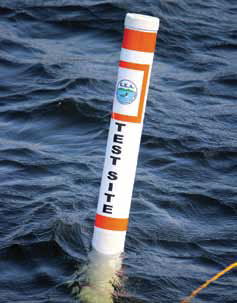Just as a taking a person’s temperature helps assess human health, checking water temperature reveals a lot about a lake’s overall health.
To get a better idea of temperature patterns in Moose Pond, LEA began monitoring the temperature using in-water data loggers in 2013.
The loggers, also known as HOBO® sensors, are small, digital temperature sensors that have been programmed to record readings every fifteen minutes at various depths.
At the deepest section of each of the pond’s three basins, you’ll see an upright buoy—this is the sensor, which stores data until LEA retrieves it.
The measurements allow researchers to examine a temperature profile of the pond and infer its effect on diverse characteristics such as stratification (lake layering), ecology, habitat and nutrient loading. They can see how it fluctuates over time due to weather.
LEA’s Assistant Director Colin Holme says, “With the new HOBO sensors we can see when and how stratification forms and breaks down—it can also sometimes partially break down, such as when winds dig down deep enough to grab some of the cold, high nutrient water and bring it to the surface.”
Comparing temperature data over a number of years allows LEA to make observations about climate change in our region. So what did the sensors tell LEA and MPA about Moose Pond?
Last year, the temperature reached a maximum of 82.2°F in the north basin on July 3rd and 18th, 80.6°F in the middle basin on July 23rd, and 82.8°F in the south basin on July 3rd. The epilimnion, or top and warmest layer of water on the lake, was located between 0 and 5 meters for most of the summer in the middle and south basins, and between 0 and 3 meters in the north basin.
The metalimnion, or middle layer, is characterized by a large temperature change, known as the thermocline—the spot where you suddenly feel the chilly water as you dive in. This occurred around 4 meters in the north basin, between 5 and 7 meters in the south basin, and between 5 and 9 meters in the middle basin. The hypolimnion is everything below the middle layer.
Stratification deepened in all basins in mid-September, signaling the beginning of fall turnover—the time when the upper waters that had been warmed by summer’s sun cool down. Complete mixing, or turnover, occurred in the north basin on September 12th, the middle basin on November 2nd, and in the south basin on October 22nd.
If you are wondering how Moose Pond compared to other lakes in the area—in 2014, LEA reports that most of the lakes recorded their maximum temperature on July 23rd. In future years we’ll be able to see temperature trends.

